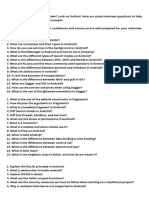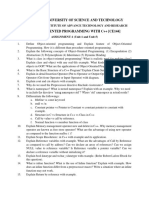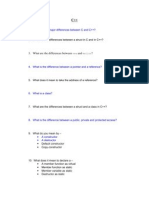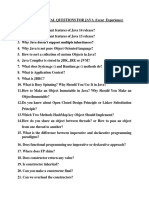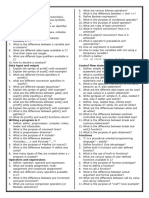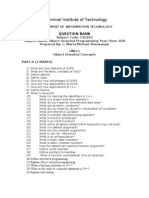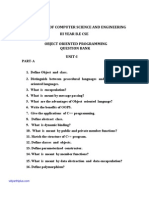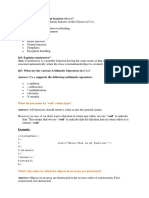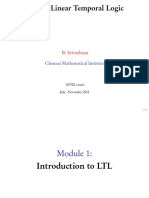0 ratings0% found this document useful (0 votes)
61 views060010203-Object Oriented Programming: Long Questions
060010203-Object Oriented Programming: Long Questions
Uploaded by
John DoeThis document contains questions about object-oriented programming concepts in C++ such as constructors, destructors, initialization, and more. Specifically, it asks about:
- Dynamic initialization and when it can be useful
- The scope resolution operator and its uses beyond separating global and local variables
- The advantages of new/delete over malloc()/free()
- The need for constructors and problems if they are not provided
- The difference between a default compiler-generated constructor and a user-defined one
Copyright:
© All Rights Reserved
Available Formats
Download as PDF, TXT or read online from Scribd
060010203-Object Oriented Programming: Long Questions
060010203-Object Oriented Programming: Long Questions
Uploaded by
John Doe0 ratings0% found this document useful (0 votes)
61 views1 pageThis document contains questions about object-oriented programming concepts in C++ such as constructors, destructors, initialization, and more. Specifically, it asks about:
- Dynamic initialization and when it can be useful
- The scope resolution operator and its uses beyond separating global and local variables
- The advantages of new/delete over malloc()/free()
- The need for constructors and problems if they are not provided
- The difference between a default compiler-generated constructor and a user-defined one
Original Title
QBMSCIT060010203-6
Copyright
© © All Rights Reserved
Available Formats
PDF, TXT or read online from Scribd
Share this document
Did you find this document useful?
Is this content inappropriate?
This document contains questions about object-oriented programming concepts in C++ such as constructors, destructors, initialization, and more. Specifically, it asks about:
- Dynamic initialization and when it can be useful
- The scope resolution operator and its uses beyond separating global and local variables
- The advantages of new/delete over malloc()/free()
- The need for constructors and problems if they are not provided
- The difference between a default compiler-generated constructor and a user-defined one
Copyright:
© All Rights Reserved
Available Formats
Download as PDF, TXT or read online from Scribd
Download as pdf or txt
0 ratings0% found this document useful (0 votes)
61 views1 page060010203-Object Oriented Programming: Long Questions
060010203-Object Oriented Programming: Long Questions
Uploaded by
John DoeThis document contains questions about object-oriented programming concepts in C++ such as constructors, destructors, initialization, and more. Specifically, it asks about:
- Dynamic initialization and when it can be useful
- The scope resolution operator and its uses beyond separating global and local variables
- The advantages of new/delete over malloc()/free()
- The need for constructors and problems if they are not provided
- The difference between a default compiler-generated constructor and a user-defined one
Copyright:
© All Rights Reserved
Available Formats
Download as PDF, TXT or read online from Scribd
Download as pdf or txt
You are on page 1of 1
060010203-Object Oriented Programming 2014
5. Define copy constructor.
6. Define default constructor.
7. Define destructor.
8. What is dynamic initialization?
9. Define explicit constructor.
10. What is initialization of the object?
11. What is member initialization list?
12. What is parameterized constructor?
13. When destructor will get invoked?
14. What is constructor overloading?
15. Define nameless object.
16. Use of copy constructor.
17. What is constant object?
18. What is constant constructor?
19. What is nested class?
Long Questions:
1. What is dynamic initialization? Where it can be useful?
2. What is the use of scope resolution operator? Suggest an example of its use in
practical circumstances. Does it have any use other than separating out global
variables from local variables?
3. What are the advantages of new and delete operators over malloc() and free()
functions.
4. What is the need for initialization of objects using a constructor? What could be the
problems if constructors are not provided in C++?
5. What are the functions of constructor? How are they different from normal
functions?
6. What is the difference between default constructor provided compiler and a user-
define default constructor?
7. List the cases where default constructor provided by user becomes necessary.
8. What is meant by dynamic reinitializing an object? What is the difference between
normal initialization and dynamic initialization?
9. We may need constructor in every class that we define; but we may need destructor
in few classes only. Why?
10. What is the life-time of an object? What is the relation of the lifetime of an object to
the constructor and destructor?
11. When we need the copy constructor in the definition of a class? Justify your answer.
12. What are the constructors and destructors? Explain how they differ from normal
function.
13. What are the differences between default and parameterized constructors?
14. What are the copy constructors and explain their need?
15. What is the order of construction and destruction of object?
16. What are read only objects? What is the role of constructor in creating such objects?
17. What is need for initialization of objects using a constructor? What could be the
Ms. Anuja Vaidya Page 6
You might also like
- ISACA CISA v2022-01-10 q320Document78 pagesISACA CISA v2022-01-10 q320Jalaludeen S100% (1)
- Economic Survey 2021-22: Government of Himachal PradeshDocument321 pagesEconomic Survey 2021-22: Government of Himachal PradeshJohn DoeNo ratings yet
- X3 Development - Class-Representation ConceptsDocument201 pagesX3 Development - Class-Representation ConceptsSteveNo ratings yet
- 1 P6 VX Ek 8 F C6 TWR W9 JBZCW 5Document6 pages1 P6 VX Ek 8 F C6 TWR W9 JBZCW 5satyamprouNo ratings yet
- C++ Interview Questions and Answers For Freshers PDFDocument5 pagesC++ Interview Questions and Answers For Freshers PDFiqshub100% (1)
- RN LevelsDocument5 pagesRN LevelsMohit DubeyNo ratings yet
- CS/IT Branch CRT (Technical) Technical Interview Question BankDocument40 pagesCS/IT Branch CRT (Technical) Technical Interview Question BankYouTuneNo ratings yet
- Wa0005Document4 pagesWa0005ashikreji583No ratings yet
- Android Interview QuestionDocument3 pagesAndroid Interview QuestionKashif MehmoodNo ratings yet
- MC7201-Object Oriented Programming Question Bank - EditedDocument7 pagesMC7201-Object Oriented Programming Question Bank - EditedArun Raja100% (1)
- BO Interview QuestionsDocument1 pageBO Interview QuestionsAmar AleNo ratings yet
- Charotar University of Science and TechnologyDocument2 pagesCharotar University of Science and TechnologyShashwat ShahNo ratings yet
- Hexaware Interview Round QuestionDocument10 pagesHexaware Interview Round QuestionBirendra BangariNo ratings yet
- What Are The Major Differences Between C and C++?Document2 pagesWhat Are The Major Differences Between C and C++?jadhavsmitNo ratings yet
- UNIT 3 and 4 Question BankDocument2 pagesUNIT 3 and 4 Question Bankanshikavrindatyagi.2005No ratings yet
- Complied List of Java Interview Question by Umesh KaushikDocument4 pagesComplied List of Java Interview Question by Umesh KaushikParag MaskeNo ratings yet
- Java Reference Interview QuestionsDocument9 pagesJava Reference Interview QuestionsemeetabhiNo ratings yet
- OopDocument31 pagesOoppragati patil100% (1)
- Growexx Questions 30.08.2022Document8 pagesGrowexx Questions 30.08.2022Abhay RajputNo ratings yet
- Softvamp Techno Solutions - TECHNICAL QUESTIONS For JAVA 1 Year ExperienceDocument2 pagesSoftvamp Techno Solutions - TECHNICAL QUESTIONS For JAVA 1 Year Experiencesoft VampNo ratings yet
- OOP Question BankDocument1 pageOOP Question BankMr VenkiNo ratings yet
- CPP Question Bank 2024-25Document3 pagesCPP Question Bank 2024-25kiranhandifod112No ratings yet
- Random Interview Questions On Objective CDocument4 pagesRandom Interview Questions On Objective Cgregory3No ratings yet
- प्रश्नच प्रश्न मराठी Coders CCPP QuestionsDocument111 pagesप्रश्नच प्रश्न मराठी Coders CCPP Questionssiddheshn80No ratings yet
- Java Interview Questions Sample..Document10 pagesJava Interview Questions Sample..Mayank SikarwalNo ratings yet
- Frontend Interview QuestionsDocument13 pagesFrontend Interview QuestionsYoussef IbrahemNo ratings yet
- DS & OOPS Question BankDocument16 pagesDS & OOPS Question BankJose ClarkNo ratings yet
- PDF 5Document27 pagesPDF 5dodo sNo ratings yet
- FSD Question BankDocument6 pagesFSD Question Bankmocetow663No ratings yet
- Important Questions in C++Document1 pageImportant Questions in C++abhishek singh50% (2)
- UST Global Interview QuestionsDocument3 pagesUST Global Interview Questionssurya191mNo ratings yet
- CS2203 QBDocument7 pagesCS2203 QBAnish TpNo ratings yet
- Interview Questions: Etiam Sit Amet EstDocument29 pagesInterview Questions: Etiam Sit Amet Estrahul kumarNo ratings yet
- Questions 2024 - BcaDocument3 pagesQuestions 2024 - Bcasaritbarua29No ratings yet
- Oops Important QuestionsDocument9 pagesOops Important QuestionsJPR EEE100% (3)
- 060010203-Object Oriented Programming: Fill in The BlanksDocument1 page060010203-Object Oriented Programming: Fill in The BlanksJohn DoeNo ratings yet
- Jio Interview QuestionDocument3 pagesJio Interview QuestionMayur GuptaNo ratings yet
- Oops Question Bank (Cs 2203)Document9 pagesOops Question Bank (Cs 2203)CSETUBENo ratings yet
- Varanasi Public School: Computer ScienceDocument1 pageVaranasi Public School: Computer ScienceVaibhaw RaiNo ratings yet
- C One Mark QuestionsDocument2 pagesC One Mark Questionsmanasabezawada04No ratings yet
- Oops Question Bank MichaelDocument9 pagesOops Question Bank Michaelmichael100% (1)
- OOPS - Vel - 1st EditionDocument7 pagesOOPS - Vel - 1st EditionvanckamNo ratings yet
- DOC-20250107-WA0010.Document1 pageDOC-20250107-WA0010.BARUN SINGHNo ratings yet
- Niyaz Sir PDFDocument4 pagesNiyaz Sir PDFumamucheli34No ratings yet
- Question Bank OopsDocument8 pagesQuestion Bank Oopsukbalaji85No ratings yet
- Question Bank BCS403Document5 pagesQuestion Bank BCS403iamvansh22No ratings yet
- Answer All Questions.: N R N RDocument1 pageAnswer All Questions.: N R N RBean ShinchanNo ratings yet
- Department of Computer Science and Engineering Iii Year B.E Cse Object Oriented Programming Question Bank Unit-IDocument9 pagesDepartment of Computer Science and Engineering Iii Year B.E Cse Object Oriented Programming Question Bank Unit-IJennifer KingNo ratings yet
- C/C++ QuestionsDocument8 pagesC/C++ Questionschandan1757051No ratings yet
- 1.1 100 C# Interview QuestionsDocument31 pages1.1 100 C# Interview QuestionsrahmonberdiyevbotiraliNo ratings yet
- Sample Questions On Computer Science SubjectsDocument19 pagesSample Questions On Computer Science SubjectsruchiNo ratings yet
- Intrebari Interviu ProgramatorDocument7 pagesIntrebari Interviu Programatorionel stefanucaNo ratings yet
- What Do You Mean by Void' Return Type?Document4 pagesWhat Do You Mean by Void' Return Type?Gurpreet SharmaNo ratings yet
- Salesforce Admin Interview QuestionsDocument8 pagesSalesforce Admin Interview QuestionsSDBNo ratings yet
- Viva QuestionsDocument4 pagesViva QuestionsstrikeyouareoutNo ratings yet
- Pynux Soft SolutionsDocument2 pagesPynux Soft SolutionsPynux Soft SolutionsNo ratings yet
- Java Full Question BankDocument5 pagesJava Full Question BankArib AhmedNo ratings yet
- Sap 2Document1 pageSap 2soumikroy620No ratings yet
- TCS Technical Interview QuestionsDocument15 pagesTCS Technical Interview Questionsraj kumarNo ratings yet
- Java Interview QuestionsDocument5 pagesJava Interview QuestionsVijay KumarNo ratings yet
- Spring and Spring Boot Interview Questions and Answers. Tech interviewer’s notesFrom EverandSpring and Spring Boot Interview Questions and Answers. Tech interviewer’s notesRating: 5 out of 5 stars5/5 (3)
- Kotlin at a Glance: Use of Lambdas and higher-order functions to write more concise, clean, reusable, and simple codeFrom EverandKotlin at a Glance: Use of Lambdas and higher-order functions to write more concise, clean, reusable, and simple codeNo ratings yet
- Implementing Design Patterns in C# 11 and .NET 7 - 2nd Edition: Learn how to design and develop robust and scalable applications using design patterns (English Edition)From EverandImplementing Design Patterns in C# 11 and .NET 7 - 2nd Edition: Learn how to design and develop robust and scalable applications using design patterns (English Edition)No ratings yet
- Econ F342 1450 1Document4 pagesEcon F342 1450 1John DoeNo ratings yet
- Why Study Quantum Computing (Latex)Document1 pageWhy Study Quantum Computing (Latex)John DoeNo ratings yet
- L11 - COVID-19 and IPR WaiverDocument4 pagesL11 - COVID-19 and IPR WaiverJohn DoeNo ratings yet
- MIT14 41F10 Pset04Document8 pagesMIT14 41F10 Pset04John DoeNo ratings yet
- B. Srivathsan: Chennai Mathematical InstituteDocument30 pagesB. Srivathsan: Chennai Mathematical InstituteJohn DoeNo ratings yet
- 060010203-Object Oriented Programming: Fill in The BlanksDocument1 page060010203-Object Oriented Programming: Fill in The BlanksJohn DoeNo ratings yet
- B. Srivathsan: Chennai Mathematical InstituteDocument44 pagesB. Srivathsan: Chennai Mathematical InstituteJohn DoeNo ratings yet
- Globalink Research Internship CV June2016Document1 pageGlobalink Research Internship CV June2016John DoeNo ratings yet
- Unit9 Module2Document60 pagesUnit9 Module2John DoeNo ratings yet
- 060010203-Object Oriented Programming: Multiple Choice QuestionDocument1 page060010203-Object Oriented Programming: Multiple Choice QuestionJohn DoeNo ratings yet
- Introduction To Object Oriented Programming Unit - 1 Short QuestionsDocument1 pageIntroduction To Object Oriented Programming Unit - 1 Short QuestionsJohn DoeNo ratings yet
- COMEDK Engineering Final Seat Availability and Fee at Beginning of Round 1Document29 pagesCOMEDK Engineering Final Seat Availability and Fee at Beginning of Round 1thshar390No ratings yet
- AvidThink Converge Network Digest Next Gen Infrastructure Acceleration SmartNICs Report 2020 Rev CDocument18 pagesAvidThink Converge Network Digest Next Gen Infrastructure Acceleration SmartNICs Report 2020 Rev CLeón CarruselNo ratings yet
- Computer Science Investigatory ProjectDocument31 pagesComputer Science Investigatory ProjectRonit RoyNo ratings yet
- Polymorphism in JavaDocument54 pagesPolymorphism in JavaTechVeerendra's Software SolutionsNo ratings yet
- MXL User ManualDocument45 pagesMXL User ManualOld Customs Cars ServicesNo ratings yet
- CSE 241 Algorithms MidtermDocument21 pagesCSE 241 Algorithms MidtermLakad ChowdhuryNo ratings yet
- 19bcs2518 Sourav ThakurDocument1 page19bcs2518 Sourav ThakurSourav ThakurNo ratings yet
- 5GC ArchitectureDocument11 pages5GC ArchitectureDaler ShorahmonovNo ratings yet
- Preparing For A Technical IOS Job InterviewDocument120 pagesPreparing For A Technical IOS Job Interviewmaksym.poltoradnyaNo ratings yet
- Resume SwethaDocument4 pagesResume SwethaGuar GumNo ratings yet
- EPS Roaming Guidelines 23 November 2021: This Is A Non-Binding Permanent Reference Document of The GSMADocument109 pagesEPS Roaming Guidelines 23 November 2021: This Is A Non-Binding Permanent Reference Document of The GSMAtatyana.liNo ratings yet
- Digital Design Interview Questions Part 1 - Vlsi4freshersDocument4 pagesDigital Design Interview Questions Part 1 - Vlsi4freshersMADDALA RAMYA (N170498)No ratings yet
- Frank Ayirebi ResumeDocument2 pagesFrank Ayirebi Resumedurga prasad ravvaNo ratings yet
- Chap3 Slides Week4Document42 pagesChap3 Slides Week4A NNo ratings yet
- Pan Os Cli Quick Start 6Document886 pagesPan Os Cli Quick Start 6cemerlang satuNo ratings yet
- Resume For It Help Desk SupportDocument5 pagesResume For It Help Desk Supportkvrtfwqmd100% (1)
- Introduction To Networks - Network Representations and TopologiesDocument3 pagesIntroduction To Networks - Network Representations and TopologiesZulkifliNo ratings yet
- Structured Programming Versus Object-Oriented ProgrammingDocument10 pagesStructured Programming Versus Object-Oriented ProgrammingVikas VermaNo ratings yet
- ISTQB CT AuT Sample Exam A Questions v2.2Document17 pagesISTQB CT AuT Sample Exam A Questions v2.2monika bhusaNo ratings yet
- Chapter 1Document11 pagesChapter 1Izzah AmaniNo ratings yet
- Isabela State University: Institute of Information and Communication TechnologyDocument4 pagesIsabela State University: Institute of Information and Communication TechnologyedzNo ratings yet
- T2 Telemetry Quick Start GuideDocument28 pagesT2 Telemetry Quick Start GuideRom AureNo ratings yet
- Manual GCsolution AgentDocument111 pagesManual GCsolution AgentAbdul KalimNo ratings yet
- 10 Worst Computer Viruses of All TimeDocument9 pages10 Worst Computer Viruses of All TimeKatz EscañoNo ratings yet
- Design and Analysis of Algorithms - Assignment #3Document55 pagesDesign and Analysis of Algorithms - Assignment #3bhattifarhan182No ratings yet
- Wireshark Lab: TCP: Approach, 7 Ed., J.F. Kurose and K.W. RossDocument11 pagesWireshark Lab: TCP: Approach, 7 Ed., J.F. Kurose and K.W. RossCarlos HenriqueNo ratings yet
- 07WS PAS Install PSMDocument71 pages07WS PAS Install PSMMarcel Friesen100% (1)
- Royal Software Engineer's AlgorithmDocument6 pagesRoyal Software Engineer's AlgorithmSaif YounusNo ratings yet








